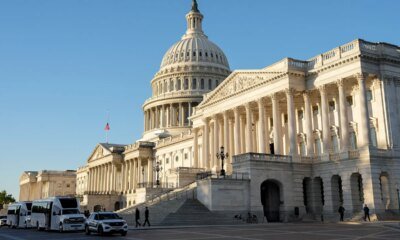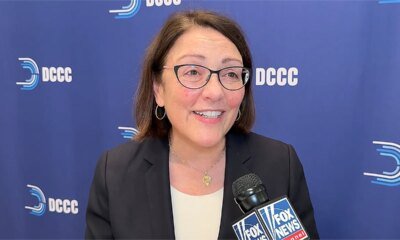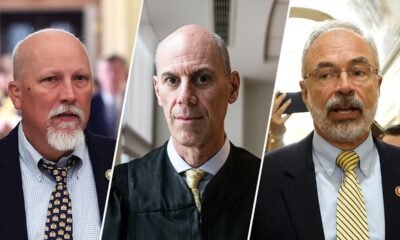INTERNACIONAL
Trump’s ‘big, beautiful bill’ passes key House hurdle after GOP rebel mutiny

President Donald Trump’s «one big, beautiful bill» survived a key hurdle in the House of Representatives on Sunday night, putting it one step closer to a chamber-wide vote later this week.
It comes after a rebellion by four House conservatives upended plans to advance the bill on Friday morning.
Lawmakers on the House Budget Committee were summoned back to Washington for a 10 p.m. meeting to vote on advancing the legislation. It passed the panel in a nearly party-line vote, 17 to 16, with four Republicans voting «present.»
Speaker Mike Johnson, R-La., made a surprise appearance in the committee room shortly before the vote began, telling reporters, «We think this is going to go well tonight. We’re about to find out.»
He said there would likely be «minor modifications» to the final bill before disappearing into a back room with the four GOP holdouts who sunk the bill on Friday morning.
ANTI-ABORTION PROVIDER MEASURE IN TRUMP’S ‘BIG, BEAUTIFUL BILL’ COULD SPARK HOUSE GOP REBELLION
Trump is pictured in front of the US Capitol Building on Friday, January 17, 2025. (Fox News Digital/Trump-Vance Transition Team)
Johnson spoke to reporters again just before the vote began.
«I think what is about to happen here is that every member, every Republican member, will give a vote that allows us to proceed forward, and we count that as a big win tonight,» he said.
The speaker said he expects to have «productive discussions» with various factions of the House GOP, adding, «I am absolutely convinced we’re going to get this in final form and pass it in accordance with our original deadline.»
It comes after a rebellion by four conservative House Freedom Caucus members on the committee blocked the bill from advancing on Friday, with the fiscal hawks seeking assurances that stricter crackdowns on Medicaid and green energy subsidies in the Inflation Reduction Act (IRA) would be in the final bill before a House-wide vote.
The four conservatives voted «present» in an effort to move discussions forward on Sunday night.
Advancing the legislation through the House Budget Committee is a largely procedural move. Lawmakers have signaled that some changes will be introduced as amendments in the House Rules Committee, the final gatekeeper before a House-wide vote, sometime early this week.
Notably, two of the Budget Committee fiscal hawks who demanded further changes – Reps. Chip Roy, R-Texas, and Ralph Norman, R-S.C. – also sit on the House Rules Committee.
«In an effort to move this bill forward, I’m excited about the changes we’ve made. And I will vote present,» Norman said as voting began.
The House Budget Committee passed a framework earlier this year with «instructions» for various other committees to enact Trump policies under their jurisdictions.
Following House and Senate-wide votes on their frameworks, House committees began crafting those policies, which have now been put back together into the massive bill the House Budget Committee advanced on Sunday night.
BROWN UNIVERSITY IN GOP CROSSHAIRS AFTER STUDENT’S DOGE-LIKE EMAIL KICKS OFF FRENZY

Rep. Chip Roy, R-Texas, is seen outside the U.S. Capitol after the last votes before the August recess on Thursday, July 25, 2024 (Tom Williams/CQ-Roll Call, Inc via Getty Images)
Republicans are working to pass Trump’s agenda via the budget reconciliation process, which allows the party controlling both Congress and the White House to pass vast pieces of legislation while completely sidelining the minority – in this case, Democrats.
It does so by lowering the Senate’s threshold for passage from 60 votes to 51, lining up with the House’s own simple majority. The legislation must adhere to a specific set of rules, however, including only items related to federal spending, tax, and the national debt.
Trump is having Republicans use the legislation to enact his campaign promises on tax cuts, immigration, energy, defense, and raising the debt limit.
And while quelling Friday’s GOP mutiny is a victory for House Republican leaders, lawmakers will still have to sit through high-stakes negotiations on any changes made to the bill before the House Rules Committee considers it.
Conservatives are opposed to aspects of the legislation’s crackdown on Medicaid, which Republicans have said they are only trimming for waste, fraud, and abuse. But Medicaid work requirements for able-bodied people are not set to kick in until 2029, and conservatives have argued that it was a large window of time for those changes to be undone, among other concerns.
They’re also pushing for a more aggressive effort to repeal green energy tax subsidies passed in the former Biden administration’s Inflation Reduction Act (IRA).
The respective pushes have pitted them against moderates wary of significant Medicaid cuts, and Republican lawmakers whose districts have businesses that have benefited from the tax relief.
Meanwhile, moderates in high-cost-of-living areas have also pushed for larger state and local tax (SALT) deduction caps, which red state Republicans have largely dismissed as subsidies to high-tax blue states.
CLICK HERE TO GET THE FOX NEWS APP
The Republicans in those seats, however, have argued that it’s an existential issue for their districts, where GOP victories were critical to winning and holding the House majority.
But even after it passes the House, Republicans there likely won’t be done with the «big, beautiful bill» – Republican senators have already signaled they are likely going to make changes to the bill.
Johnson said on Fox News Sunday that House and Senate leaders were «in close coordination» on the final product, adding, «we hope that they don’t make many modifications to it.»
Any changes will have to go through the House again; identical bills must pass both chambers before getting signed into law by Trump.
Republican leaders have said they hope to get a bill on the president’s desk by Fourth of July.
House Of Representatives,Republicans,House Budget
INTERNACIONAL
Las grandes ciudades modernas desafían la biología humana y podrían afectar su evolución, afirma un estudio
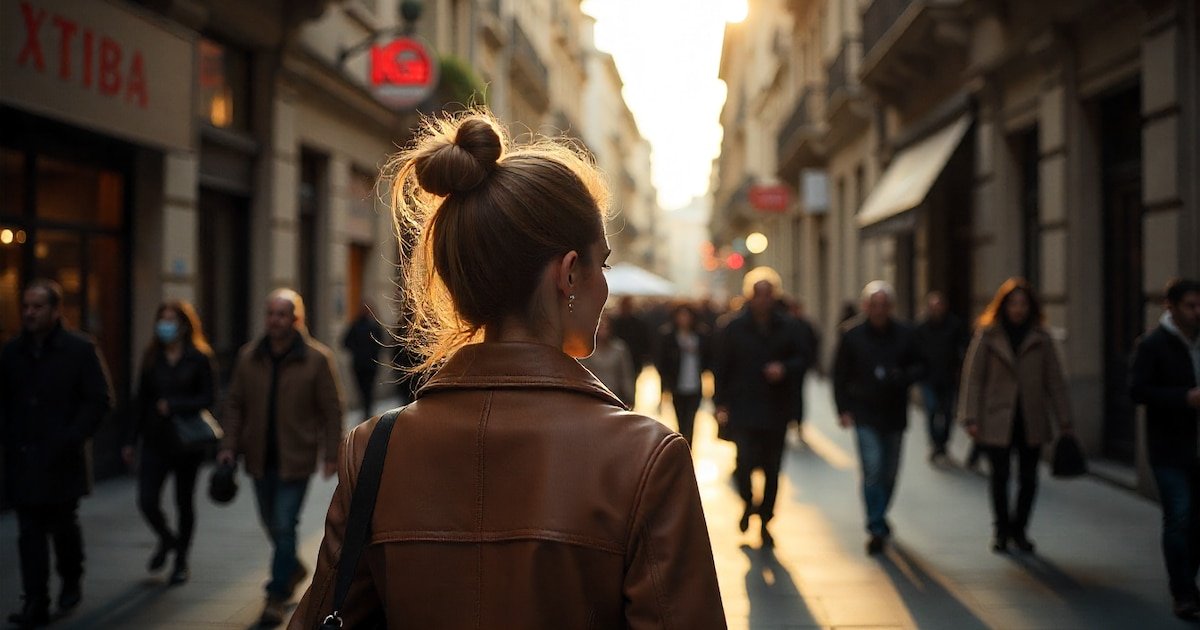
Vivir en grandes ciudades representa, para los científicos evolucionistas de la Universidad de Loughborough y la Universidad de Zúrich, un reto para la naturaleza humana. Según advierten, la acelerada urbanización desborda la capacidad de adaptación de nuestra especie y afecta el bienestar físico y mental.
El ser humano comenzó a modificar su entorno hace miles de años, pero la industrialización del siglo XVIII aceleró radicalmente la transformación del hábitat. En la actualidad, la mayor parte de la población mundial reside en áreas urbanas densas, expuesta a contaminación, ruido, luz artificial y con acceso limitado a la naturaleza.
En países como Canadá, Estados Unidos y Reino Unido, se estima que las personas pasan hasta el 93% del tiempo en espacios cerrados. Estas condiciones representan una ruptura drástica respecto de las que predominaron durante la evolución de la especie.

Según datos de la ONU citados en Biological Reviews, en 2018 el 55% de la humanidad ya vivía en ciudades y, para 2050, la cifra superará el 68%. Así, el Homo sapiens se ha convertido en una especie urbana, enfrentando desafíos que su biología no termina de asimilar.
La denominada hipótesis del desajuste ambiental advierte que la evolución humana, calibrada durante miles de generaciones en entornos naturales, no puede seguir el ritmo vertiginoso de las transformaciones urbanas.
“Nuestra biología fue moldeada por entornos naturales, pero la industrialización transformó el mundo más rápido de lo que nuestros cuerpos pueden adaptarse”, señaló Danny Longman, especialista en fisiología evolutiva humana de la Universidad de Loughborough, a Newsweek. Ese desfase —denominado “lag adaptativo”— expone al organismo a nuevos riesgos y desajustes para los que no está preparado.

- Función reproductiva: la fertilidad mundial desciende, y dos tercios de la población viven en países con tasas por debajo del reemplazo. Biological Reviews atribuye esta tendencia, entre otros factores, a la exposición cotidiana a contaminantes como pesticidas, microplásticos y productos químicos industriales. Estas sustancias alteran la producción hormonal y afectan la calidad del esperma y la salud reproductiva tanto de hombres como de mujeres.
- Función inmunológica: el sistema inmunitario humano resulta menos eficiente en contextos urbanos por la menor exposición a microorganismos beneficiosos y el aumento de agentes contaminantes en el aire, el ruido y la luz artificial. Esto favorece las alergias, enfermedades autoinmunes e inflamaciones crónicas. Estudios recientes indican que niños y adultos urbanos muestran más alergias y menor respuesta inmunitaria que quienes viven en contacto frecuente con la naturaleza.
- Cognición: la sobrestimulación digital, el ruido, la contaminación y la falta de áreas verdes impactan en la atención, la memoria y la flexibilidad mental. Investigaciones muestran que quienes crecen en barrios densamente urbanizados presentan desarrollos cognitivos más lentos y mayores riesgos de deterioro cerebral en la adultez. Incluso caminar en entornos urbanos puede disminuir el rendimiento intelectual frente al contacto con la naturaleza.
- Condición física: la fuerza y la resistencia físicas también se ven perjudicadas por el sedentarismo, la contaminación y la ausencia de espacios verdes. Niños y adolescentes urbanos tienen peor condición cardiovascular y muscular en comparación con sus pares rurales. En personas adultas, la debilidad y el declive funcional aparecen a edades más tempranas, relacionados con la exposición a partículas contaminantes y la falta de movimiento.

El estrés crónico es uno de los efectos más extendidos de la vida urbana. “El ruido constante, las multitudes, el tráfico, la sobrecarga digital y la escasez de escenarios naturales mantienen nuestro sistema de alerta en estado de activación permanente”, advierte Longman. Esto se traduce en aumento de ansiedad, alteraciones del sueño, trastornos cardiovasculares, síntomas inmunológicos y reproductivos, y deterioro cognitivo.
La evidencia científica lo respalda: Biological Reviews confirma que la exposición diaria a ambientes industrializados incrementa los biomarcadores de estrés y eleva la incidencia de trastornos psicológicos y físicos. Por el contrario, la presencia de espacios verdes en el entorno actúa como factor protector, moderando los efectos negativos del estrés y mejorando la salud integral.
El trabajo liderado por Longman y su equipo señala que la biología de nuestra especie está profundamente condicionada por la herencia evolutiva en contacto con la naturaleza, lo que vuelve difícil la adaptación a un entorno urbano hiperacelerado y artificial. Según los autores, el desajuste entre el diseño biológico y el hábitat citadino explica en buena parte la tendencia al aumento de problemas reproductivos, inmunológicos, cognitivos y físicos observados en poblaciones urbanas.
El análisis final sugiere que el proceso de urbanización, si bien aportó avances tecnológicos y sociales, también ha generado consecuencias imprevistas a nivel biológico. En síntesis, la especie humana enfrenta el desafío evolutivo de habitar ciudades que en muchos aspectos resultan incompatibles con su organismo.
Cityscape,Society / Social Issues,North America
INTERNACIONAL
Obama wanted shutdown pain to be felt by Americans, while Trump kept focus on Washington, experts argue
NEWYou can now listen to Fox News articles!
President Donald Trump and former President Barack Obama are polar opposites in many ways, but, as with anyone who has sat behind the Resolute Desk, they do share some similarities.
One thing both have in common is overseeing government shutdowns — one under Obama and two under Trump. And even in that sparse similarity, both men operated differently, particularly in the most recent, 43-day closure.
While both congressional battles were centered on Obamacare, Obama put his shutdown at the center of attention, while Trump kept it at more of an arm’s length.
HOW CLOSED-DOOR NEGOTIATIONS AND A GUARANTEE ENDED LONGEST GOVERNMENT SHUTDOWN ON RECORD
President Donald Trump and former President Barack Obama handled their respective shutdowns differently, though healthcare proved to be a common thread in both. (Andrew Harnik/Getty Images; Debra L Rothenberg/WireImage)
Romina Boccia, director of budget and entitlement policy at the Cato Institute, told Fox News Digital that a major difference in the Obama and Trump administrations’ approaches to their respective shutdowns was that in 2013, Obama wanted the pain of shutdown to be felt by Americans, while Trump kept the focus centered on Washington, D.C.
«During the Obama shutdown, it was more to make it extremely visible, shut down beloved functions — even if you didn’t have to — that affect average Americans,» she said.
Boccia at the time worked for the conservative think-tank the Heritage Foundation and recalled the barricades that were swiftly erected around Washington, D.C.’s many national parks.
Those barricades, both concrete and human, spilled out beyond the nation’s capital and were placed around the hundreds of national parks across America as a stark reminder that the government was closed.
Boccia noted that a direct comparison of the two shutdowns would be difficult given the differing lengths, but that the Trump administration, at least early on, sought to inflict direct pain on congressional Democrats and the federal government.
GOP UNITY SHATTERED BY CONTROVERSIAL MEASURE IN GOVERNMENT SHUTDOWN BILL
A welcome sign is seen at Yosemite National Park in California on Dec. 13, 2023. (Tayfun Coskun/Anadolu via Getty Images)
That was carried out largely by the Office of Management and Budget Director Russ Vought, who ordered mass firings of furloughed workers and withheld or canceled billions in federal funding to blue cities and states.
«It’s not that this wasn’t a shutdown, it’s just that the choices the administration made were an attempt to focus the impacts of the shutdown this round on the government itself,» Brittany Madni, executive vice president of the Economic Policy Innovation Center, told Fox News Digital.
«This was showmanship from President Obama,» Madni continued. «And if you look at what happened over the last 40 something days, it was the exact same playbook by congressional Democrats.»
Madni argued that discussions and debate during the 2013 shutdown were centered largely in Washington, D.C. The latest closure saw some of that, but it also saw Trump continuing to work on trade deals, particularly during his high-profile visit to Asia, which was a point of contention for Democrats on the Hill.
«He was doing his job,» Madni said. «He was doing his job. Meanwhile, congressional Democrats, quite simply, were not.»
Still, there was a shared thread in both shutdowns: Obamacare.
In 2013, congressional Republicans wanted to dismantle Obama’s signature piece of legislation. Fast-forward, Senate Minority Leader Chuck Schumer, D-N.Y., led his caucus to push extensions to enhanced Obamacare subsidies.
Boccia said that played a large part in why Obama was at the vanguard during his shutdown.
«He was front and center in the media talking about the shutdown, and because it was over his legacy achievement,» she said.
SENATE REACHES TEMPORARY TRUCE TO END RECORD SHUTDOWN, BUT JANUARY BATTLE LOOMS

Senate Minority Leader Charles Schumer after a news conference in the U.S. Capitol on Nov. 5, 2025. (Tom Williams/Getty Images)
It was because his key legislative achievement was under fire that Obama took such a central role in the shutdown, Boccia argued, but for Trump, who tried during his first administration to gut and replace Obamacare, it wasn’t a priority.
«The fact that it was over the Obamacare COVID credits, I think, made the president less necessary and perhaps interested in being the face of the shutdown,» she said. «It was really a congressional battle.»
Madni disagreed that the latest shutdown wasn’t a direct bid by congressional Democrats to go after one of his legislative achievements.
Before the climactic failed vote in the Senate in late September that ushered in the longest shutdown in history, Democrats offered a counter-proposal that would have stripped several provisions from Trump’s «big, beautiful bill,» which has so far been the crowning legislative achievement of his second term.
CLICK HERE TO DOWNLOAD THE FOX NEWS APP
«It’s really important that everyone remembers the subsidy request was one request in a laundry list of radical, incredibly expensive ideas that added up to $1.5 trillion,» Madni said. «Another item in that list was dismantling key portions of the One Big Beautiful Bill Act.»
«If this was really about the subsidies, then the Democrats would have been willing at any point during the last 43 days to adjust their asks and just make it about subsidies,» she continued. «Not once did they.»
donald trump,barack obama,government shutdown,health care healthy living,politics
INTERNACIONAL
La nieta de John F. Kennedy contó que le diagnosticaron cáncer terminal el mismo día que nació su segundo hijo
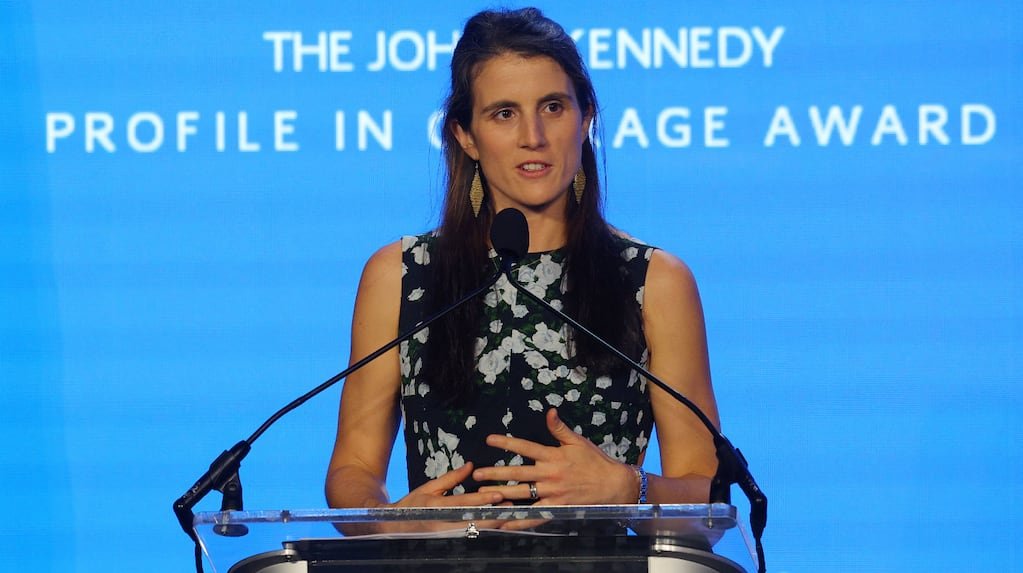
La nieta de John F. Kennedy, Tatiana Schlossberg, hizo una dolorosa revelación: en un escrito a corazón abierto, contó que padece cáncer terminal y que se enteró del diagnóstico el mismo día que nació su beba.
La impactante noticia llegó en mayo del año pasado, cuando tenía 34 años. Acababa de ser madre por segunda vez y un análisis de rutina mostró un elevado número de glóbulos blancos que se transformó en un resultado devastador: una variante con una mutación poco frecuente de una leucemia mieloide aguda.
Leé también: Alineamiento con EE.UU. y Medio Oriente: las razones del histórico cambio de postura de la Argentina en el G20
En el ensayo publicado en The New Yorker Tatiana reveló que uno de los médicos que la atiende le advirtió que podría llegar a tener solo “un año más de vida” debido a la gravedad de su cuadro.
“No podía creer que estuvieran hablando de mí. El día anterior había nadado una milla con nueve meses de embarazo. No estaba enferma”, escribió en el inicio del artículo..
A partir del diagnóstico, la mujer atravesó múltiples rondas de quimioterapia, dos trasplantes de médula ósea —el primero con células de su hermana y el segundo de un donante anónimo— y participó en ensayos clínicos experimentales. En un ensayo a corazón abierto, Schlossberg habló de la dura situación que atraviesa. (Foto: REUTERS/Brian Snyder)
En septiembre, además, le diagnosticaron una variante del virus de Epstein-Barr que afectó gravemente sus riñones y la obligó a aprender a caminar nuevamente.
“Me siento engañada y triste por no poder seguir viviendo la maravillosa vida que teníamos”, lamentó la periodista ambiental que está casada con el médico George Moran, con quien tiene dos hijos.
Durante su ensayo, Tatiana también criticó a Robert F. Kennedy Jr., sobrino de su madre y actual secretario de Salud en la administración Trump y sostuvo que las políticas que impulsa podrían perjudicar a pacientes como ella al recortar inversiones en vacunas de ARNm, tecnología que, según explicó, podría usarse contra ciertos tipos de cáncer. “Era una vergüenza para mí y para mi familia inmediata”, resaltó.
Leé también: Video: un tiroteo en plena celebración navideña terminó con cuatro heridos en Carolina del Norte
En el mismo sentido, sostuvo que los recortes federales podrían afectar a la institución en la que se trata: “De repente, el sistema de salud del que dependía se volvió inestable”, lamentó.
“Durante toda mi vida traté de ser buena hija, buena hermana, buena persona y ahora he agregado una nueva tragedia a nuestra familia, y no hay nada que pueda hacer para evitarlo”, expresó.
Schlossberg siente el peso de haber estado lejos de sus hijos, su beba de apenas poco más de un año y su hijo de 3 años, en momentos irrecuperables: no pudo cuidar a su hija por riesgo de infección y teme que, si muere, ellos apenas la recuerden. Por eso, asegura, busca dejarles buenos momentos: pequeños gestos, frases, escenas cotidianas que conserva como un archivo emocional ante la fragilidad del futuro.
Las tragedia de los Kennedy: la foto que muestra un momento antes del asesinato de John F. Kennedy (Foto archivo AP)
La periodista también le dedicó unas palabras a su pareja: “George hizo todo lo que pudo por mí. Habló con todos los médicos y aseguradoras con los que yo no quería hablar; durmió en el suelo del hospital; no se enojó cuando yo estaba furiosa por los esteroides y le grité que no me gustaba la cerveza Schweppes Ginger Ale, solo la Canada Dry. Iba a casa a acostar a nuestros hijos y volvía a traerme la cena».
Por otro lado, se refirió a su familia: “Mis padres, mi hermano y mi hermana también han criado a mis hijos y han estado en mis diversas habitaciones del hospital casi a diario durante el último año y medio. Me han sostenido con firmeza mientras he sufrido, intentando disimular su dolor y tristeza para protegerme. Esto ha sido un gran regalo, aunque siento su dolor a diario. Durante toda mi vida, he intentado ser buena, buena estudiante, buena hermana y buena hija, y proteger a mi madre y nunca hacerla enfadar ni molestar. Ahora he añadido una nueva tragedia a su vida, a la vida de nuestra familia, y no puedo hacer nada para detenerla”.
En paralelo a su lucha física, la escritora intenta sostener su identidad profesional: recuerda el libro sobre océanos que ya no podrá escribir y se aferra al sentido de su oficio para transmitirle a su hijo que su vida fue más que una larga enfermedad. Consciente de la posibilidad de un final cercano, la autora se mueve entre recuerdos de su infancia, escenas con sus hijos y reflexiones sobre la memoria y la muerte. Vive el presente como puede, aferrada al deseo de que esos momentos —aunque ella no pueda conservarlos— queden en la vida de quienes ama.
“Principalmente, intento vivir y estar con ellos ahora. Pero estar en el presente es más difícil de lo que parece, así que dejo que los recuerdos vayan y vengan. Son tantos de mi infancia que siento como si me viera crecer a mí misma y a mis hijos al mismo tiempo. A veces me engaño pensando que lo recordaré para siempre, que lo recordaré cuando muera. Obviamente, no. Pero como no sé cómo es la muerte y no hay nadie que me diga qué viene después, seguiré fingiendo. Seguiré intentando recordar”, concluyó.
Asesinatos y siniestros fatales: desde los crímenes de su abuelo John F. Kennedy en 1963 y de su tío abuelo Robert Kennedy en 1968, al accidente aéreo de su tío, John F. Kennedy Jr., en 1999, la historia de su familia está cargada de tragedias.
John F. Kennedy, nieta, Cáncer

 POLITICA2 días ago
POLITICA2 días agoTras la orden de decomiso de los bienes de CFK, la Justicia evalúa avanzar sobre el departamento de San José 1111

 POLITICA2 días ago
POLITICA2 días agoJavier Milei sobre las coimas en la ANDIS: “Hay mucha mala intención política”

 CHIMENTOS3 días ago
CHIMENTOS3 días agoEscándalo en MasterChef: cómo fingió Eugenia Tobal su eliminación tras la feroz pelea con Martitegui

